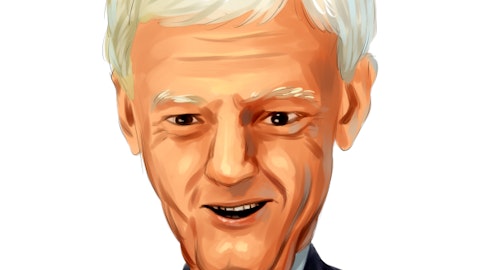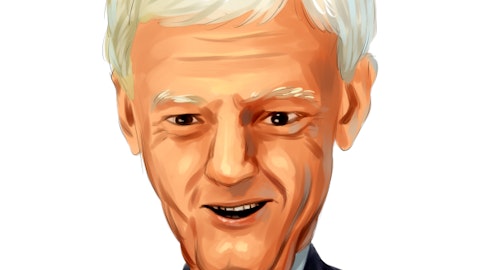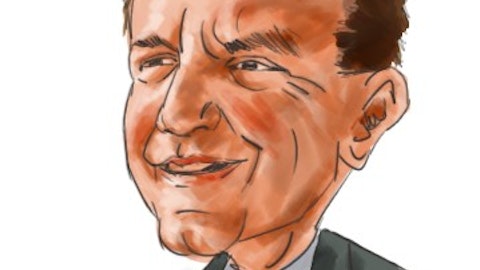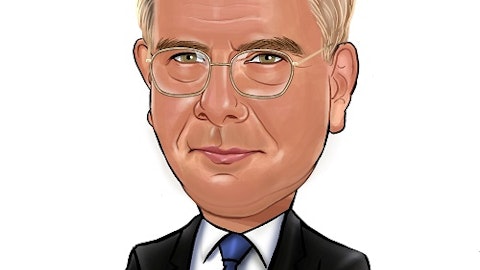Greif, Inc. (NYSE:GEF) Q4 2022 Earnings Call Transcript December 8, 2022
Greif, Inc. misses on earnings expectations. Reported EPS is $1.83 EPS, expectations were $1.93.
Operator: Good day, and thank you for standing by. Welcome to the Greif Fourth Quarter 2022 Conference Call. At this time, all participants are in a listen-only mode. After the speakers’ presentation, there’ll be a question-and-answer session. Please be advised that today’s conference is being recorded. I would now like to hand the conference over to your speaker today, Matt Leahy, Vice President of Investor Relations and Corporate Development. Please go ahead, sir.
Matt Leahy: Thanks and good morning, everyone. Welcome to Greif’s fourth quarter fiscal 2022 earnings conference call. This is Matt Leahy, Greif’s Vice President of Corporate Development and Investor Relations and I’m joined by Ole Rosgaard, Greif’s President and Chief Executive Officer; and Larry Hilsheimer, Greif’s Chief Financial Officer. We will take questions at the end of today’s call. In accordance with Regulation Fair Disclosure, please ask questions regarding issues you consider important because we are prohibited from discussing material nonpublic information with you on an individual basis. Please limit yourself to one question and one follow-up before returning to the queue. Please turn to Slide 2. As a reminder, during today’s call, we will make forward-looking statements involving plans, expectations and beliefs related to future events.
Actual results could differ materially from those discussed. Additionally, we will be referencing certain non-GAAP financial measures and reconciliation to the most directly comparable GAAP metrics can be found in the appendix of today’s presentation. And now, I turn the presentation over to Ole, on Slide 3.
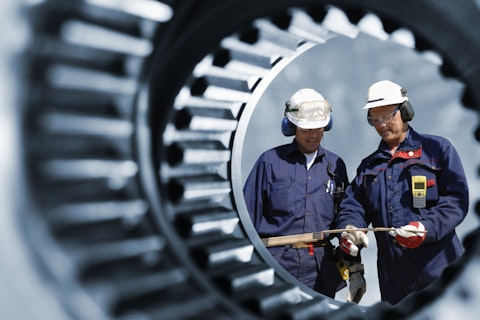
Christian Lagerek/Shutterstock.com
Ole Rosgaard: Thank you, Matt, and good morning everyone. I’m extremely proud of the results, our colleagues delivered in 2022, easily the most successful in financial terms in Greif’s history. We believe these outstanding results are driven by the high engagement among our teams. Our focus on delivering legendary customer service and our consistent commitment to value over volume approach. This year has seen headwinds related to volatility in both raw materials and other input costs, complex macroeconomic issues including the war in Ukraine and varied regulatory responses to the ongoing COVID-19 pandemic. Internally, it was also a year of change. A new executive leadership team created our Build to Last strategy, which we presented at our Investor Day in June.
I believe that change opens doors for opportunity and our results this year are evidence of the global Greif team’s ability to capture those opportunities. Therefore, before discussing our detailed fourth quarter results, I’d like to express my heartfelt appreciation for the resilience, dedication and consistency of performance from our whole Greif team. We ended the year with a strong balance sheet, record free cash generation and strong EBITDA and earnings performance when compared to a historically strong full-year ’21 comp. We do anticipate some challenges heading into 2023 but are confident, our team can manage well through any market environments and I’m excited for the year ahead. Regarding our long-term strategic objectives. The team has made excellent progress on all four missions of our Build to Last strategy.
During the past quarter, we formally launched our fifth and sixth Colleague Resource Groups furthering our diversity, equity and inclusion objectives and our goal of creating thriving communities. In the quarter, Newsweek recognized this progress by announcing Greif as number 58 on their 2022 America’s Most Loved Workplaces publication. In regard to Legendary Customer Service, we released our 12th Net Promoter Score survey, resulting in a five point improvement from the prior year. Lastly, by the end of the calendar year, we plan to release our 2030 sustainability targets, which are designed to help accelerate our progress towards protecting our future. Our sustainability leadership was recognized in the quarter through AA MSCI rating, Gold EcoVadis rating and ranking number 49 on Investor’s Business Daily Top 100 Best ESG Companies.
In addition to the record results our team achieved in 2022, I’m also excited to further discuss today, our planned acquisition of Lee Container and what that acquisition means for our strategy. Please turn to Slide 4. As discussed at Investor Day, the acquisition priorities in our GIP business are to grow in resin-based products with jerrycans being an important part of our strategic growth plan. Our most attractive targets are close to our core business of industrial packaging and add diversification benefits in product offerings, geographies and end markets served. Financially, our ideal M&A targets are immediately margin accretive supporting our margin expansion and return on capital goals outlined at Investor Day. Lee Container is an outstanding example of utilizing our disciplined M&A framework to drive growth and value for our company and shareholders.
Lee provides a strong foothold in the North America small plastics and jerrycan business segments, one in which we have expertise elsewhere in the world, which furthers our expansion into less cyclical end markets and provides a platform for continued growth through both organic and inorganic investments. Lee’s exposure to the attractive agrochemical and specialty chemical end markets support above average growth and the sustainability element of their packaging as to the attractiveness of our products and future partnership opportunities for our customers. We see the Lee team as an excellent addition to our GIP business and anticipate closing the acquisition prior to year-end. I’m very excited to welcome our new colleagues to Greif. Let’s now return to our quarterly results on Slide 5.
Our Global Industrial Packaging business experienced growing headwinds during our fiscal fourth quarter. Volumes fell across our GIP platform in most geographies as we saw sequentially declining demand through each month of the quarter. Global steel drum and plastics were down mid-single digits year-over-year. EMEA saw a step down in demand due to impacts to our customers from energy inflation and challenges related to the war in Ukraine. Similar to prior quarters, our APAC demand remains sporadic with a continued strict lockdown protocols in China impacting supply chain and industrial production, resulting in softness in most end markets excluding automotive, which has seen a modest recovery as a result of government’s incentives. North America also experienced sequential demand weakness as domestic spending and manufacturing activity slowed.
Our LatAm business remain strong in Q4 up mid-single digits of a strong Q4 ’21 comparison, due to robust demand in the citrus and transportation markets. In the fourth quarter, our GIP business also faced headwinds from the rapid decline in steel costs. In North America, steel prices declined over 43% from June to November, with a similar trend although not quite as severe in EMEA and LatAm. As we have explained in the past, rapid declines in steel negatively impacts our profitability. The lag effect on price cost drives near-term margin compression as we work through higher cost steel inventories all orders over the past three plus months, while selling at lower index adjusted prices. This headwind is temporary. But in the near term, we expect this margin pressure to continue in our steel business during the first half of fiscal ’23, as our price adjustment mechanisms continue to reset.
The combination of these factors, along with unanticipated currency impacts resulted in a year-over-year decrease in adjusted EBITDA for the fourth quarter of approximately $25 million or $17 million, excluding the $8 million contribution from our divested FPS business in Q4 ’21. Despite a lower fourth quarter, our GIP team again put up record adjusted EBITDA performance for the full fiscal 2022 on a very difficult 2021 compare and I’m proud of the team and their contribution to Greif’s results this year. Now please turn to Slide 6. Paper Packaging’s fourth quarter sales rose by approximately $44 million versus the prior year due to continued favorable price cost dynamics despite sequential month-over-month volume erosion through the quarter.
This decreased demand resulted in a total 26,000 tons of economic downtime during the quarter, approximately 23,000 of which occurred in the month of October. Fourth quarter volumes in our CorrChoice sheet feeder system were down high single-digit per day compared to the very strong Q4 ’21. This demand decline was in line with the overall box industry, which was down approximately 8% over the same periods. Fourth quarter cube and core volumes were down high single digits per day versus the prior year due to softness in film core, paper core and textile end markets despite relative strength in some end markets such as construction tubes. Despite declining demand and continued raw material cost inflation, favorable price cost led to an approximately $33 million increase in adjusted EBITDA in our PPS business, capping off a strong year of record operating performance for this business.
I’ll now turn you over to our CFO, Larry Hilsheimer on Slide 7 to discuss our Q4 financial review as well as outlook for fiscal 2023.
See also 10 Most Undervalued Stocks To Buy and Stocks On the Rise: 12 Best Stocks To Buy.
Larry Hilsheimer: Thank you, Ole. Good morning, everyone. I want to start by reiterating Ole’s opening comment of how proud we are of our team’s performance in 2022. This was a record year financially for Greif across every measure and I attribute our success to the relentless dedication by every Greif colleagues to serve our customers with excellence. Clearly, we’ve had some economic tailwinds the past few years. But as they rapidly disappeared in the second half of fiscal 2022, our teams did an outstanding job of managing through the challenges. Now onto our results. I’ll start by addressing the obvious. In early November, we announced a reaffirmation of our Q3 guidance as part of our participation at the 2022 Baird Industrials Conference.
Our final Q4 EPS result of $1.83 results on – results in a full year non-GAAP EPS of $7.87 per share, which is $0.03 below the low end of our reaffirmed range. Our affirmation was issued with the best information available as of the date release, which was prior to finalization of our year-end clos procedures. While our above the line results came on the lower side of our expectations due to demand deterioration, it was that plus the combination of higher other expense from $4 million of negative currency impacts and higher than anticipated tax expense resulting from an unfavorable mix of jurisdictional income and tax return examination adjustments that drove our earnings per share below the low end of our range. While this was a frustrating development related earnings, I’m pleased to report that in Q4, we posted solid gross profit and EBITDA growth despite lower sales, as well as stable SG&A on a percent of sales basis and another quarter of record free cash flow.
I would like to specifically recognize our teams for their strong execution on working capital as volumes slowed in the fourth quarter. We’ve often cited our potential to generate cash when demand turns and this was — this was a quarter with a prime example of our agility and further evidence of the resilience of our business model. We closed out 2022 having crushed the midpoints of our original 2022 commitments made at our Investor Day in June of 2019 by nearly $60 million on EBITDA and over $75 million on free cash flow of the commitments we made at our Investor Day was that we would achieve gross profit margins over 20%, SG&A below 10% and operating profit above 10%. We delivered on each at 20.7%, 9.4%, and 11.3 %respectfully. I’m extremely proud of our team.
Let’s now turn to Slide 8 to further discuss 2023 outlook and guidance. We’ve made the decision to begin presenting guidance on an adjusted EBITDA and adjusted free cash flow basis and de-emphasize earnings per share as the primary guidance metric. We feel that EBITDA and free cash flow are better representations of the ongoing results of our business, especially given our intention to continue to grow via acquisitions. Earnings per share is often transitionally impacted by below the line adjustments made to accommodate impacts from acquisitions and divestitures, as well as changes to our capital structure, resulting from transactions and changing leverage from other non-operating adjustments and from a changing mix of jurisdictional income, which impacts accuracy around tax forecasting.
We firmly believe that EBITDA and free cash flow are better representations of the true economics of our business and guiding along these measures will provide better transparency and clarity to both internal and external shareholders. We will continue to report adjusted earnings and earnings per share as before and while we are no longer formally guide to EPS, we will give directional and information – informative context to our below the line expectations as part of our quarterly earnings call. With that context provided for fiscal 2023, we anticipate generating between $820 million and $906 million of adjusted EBITDA and between $410 million and $460 million of adjusted free cash flow for the full year, which includes the impact of higher planned CapEx. On Slide 8, we provide the key assumptions, which are included in our guidance range.
You will note that our range is slightly wider than usual. We anticipate refining our range during fiscal ’23. However, given the highly uncertain macroeconomic environment, we have determined there’s too much variability and expectations to release a range tighter than what is provided. We will be monitoring the dynamic changes in the market and we’ll update the investment community further, as we progress through 2023 and will revise our guidance range as warranted. Please turn to Slide 9. In closing, I want to remind investors of the strength of our balance sheet and our commitment to our capital allocation strategy outlined at Investor Day. As we come off a record year in 2022, and enter a more uncertain path in 2023, our focus on disciplined capital allocation becomes even more important.
We currently sit over 25 basis points below our target leverage ratio range of 2x to 2.5x net debt to EBITDA and with the acquisition of Lee Container, we anticipate being back to the low end of our range by the end of 2023. We remain committed to our plan to increase our dividend, continue our share repurchases and invest in our business. Our M&A pipeline remains robust and Greif will continue to pursue our acquisition strategy to elevate the breadth and quality of the businesses and our portfolio. I am proud of the work we’ve done and the work we have ahead of us as we enter 2023 and advance on our Build to Last strategy. With that, I’ll turn things back to Ole, on Slide 10.
Ole Rosgaard: Thanks, Larry. To sum up our thoughts, fiscal 2022 was a record year for Greif in many respects and we again would like to thank each and every one of our colleagues for being a part of making those results possible. As we look into 2023, uncertainty does exist. And while our guidance reflects expected results lower than in 2022 numbers due to the macroeconomic environments, we have discussed, they will constitute the second highest EBITDA and free cash flow output in the 145 year history of Greif. We have been through downturns like this. The teams know how to win in this environment, and we will be successful. We are excited for the year ahead and to continue to produce results worthy of your investment in our company. We thank you for your interest in Greif. Norma, please open the lines for questions.
Q&A Session
Follow Greif Inc (NYSE:GEF,GEF.B)
Follow Greif Inc (NYSE:GEF,GEF.B)
Operator: Thank you. Our first question comes from the line of Ghansham Panjabi with RW Baird. Your line is now open.
Ghansham Panjabi: Thank you. Good morning, everyone, and congrats on a really amazing year. As we kind of think back to fiscal year ’22 and as we came into the year, it was clear that the PPS segment will start to benefit from margin expansion and is likely be some sort of moderation in GIP, just given the outsized fiscal year ’21 for that segment. On that basis, how do you sort of think that segment dynamics will play out in fiscal year ’23 based on what you see occurred?
Larry Hilsheimer: Yes. Thank you, Ghansham. This goes back to what we’ve talked about the fact that our two business units tend to offset each other, just because of the pricing lag in PPS. And it did, as you mentioned play that way through ’22. For ’23, our first quarter in first half of the year, GIP is going to be extremely weak. The demand deterioration in the market has been pretty significant and that combined with the rapid decrease in the cost of steel, it plays out through us as we’ve explained in the past and as Ole commented in his comments, that will squeeze our margin pretty significantly. We expect that the things will — with that our price adjustment mechanisms will catch up with that through the second quarter and in the rest of the year demand should pick up and you’ll see sort of the opposite flow through where our PPS, we believe will be very strong for second quarter and should continue reasonably well through the year as we think things will pick up in the second half of the year.
Ghansham Panjabi: Okay, perfect. And for my second question, Larry, maybe you could just help us with the bridge on EBITDA, ’23 versus ’22, obviously you have a very wide range for ’23. So, maybe the mid-point differential? What are the big moving pieces there?
Larry Hilsheimer: Yes, Ghansham, we — usually we would walk down the midpoint. But I’ll tell you, given the macroeconomic uncertainty we have approached it in a different manner this year, where we just really took each of the variables and did multiple scenario plans and laid them across the chart and just use that to frame our upside and downside. And so for example, we looked at OCC and we think that it will be somewhere in the range of 35 to 90 throughout the year and probably trending upward through the year. Everybody keeps talking about capacity additions, as capacity comes on, there’ll be some, I’d say artificial bump in demand on efficiency because they can only produce so much and markets got to have end demand for everybody, at some point but, so we scaled out our OCC assumption.
We’ve done scenario planning on pricing and paper business across our grades, multiple different ones, you’ve flat, you have some increase, decrease. We don’t actually have any with increases in pricing at any time in the year but modeling out different alternatives. And then just pace demand on the side of the GIP business. So I know that’s not all that helpful in terms of a midpoint analysis, but if I give you a little bit, I would say from an operation standpoint, we think the high end of things is a potential decrease of $12 million from this year’s overall EBITDA to a potential decrease of $98 million on EBITDA across all of the operational factors. That does include uplift from Lee Container. We also have, just remember, we had a divestiture of FPS which was about $16 million of EBITDA that was included in fiscal ’22, so that’s gone and we also cats and dogs immaterial things that we’re in the process of disposing.
They’ll take another $10 million to $12 million of EBITDA out and generate some proceeds from us for us as those things play out over the next couple of quarters.
Ghansham Panjabi: Okay. Perfect. Thank you and happy holidays to all of you.
Larry Hilsheimer: Thank you, Ghansham. Thank you.
Operator: Thank you. One moment please for our next question please. Our next question comes from Adam Josephson with KeyBanc. Your line is now open.
Adam Josephson: Ole, Larry, Matt, good morning. Thanks very much for taking my questions. Hope you’re well. Larry, just — it sounds like in the PPS business, you’re expecting to have a much better year than in the GIP business, and I know, aided by OCC having fallen quite considerably, you gave us your range for OCC. Obviously, you’re not — I presume you’re not going to talk about your containerboard and boxboard pricing assumptions relative to your OCC price assumption. So can you help us — I mean this is a spread business, obviously. And it’s hard to know how to think about how conservative or perhaps aggressive your guidance is without knowing what spread you’re assuming between prices and costs next year, along with whatever you’re assuming demand will be. So is there any more clarity you could give us on what you’re assuming in PPS in terms of the spread between prices and costs and what you’re assuming for demand?
Larry Hilsheimer: Yes. Not really, Adam. I mean we — like I said, we did a bunch of different scenario plans have looked across it. And so what I gave in the answer to Ghansham as deep as we’re going to go into specifics on it. What I would say is, look, our worst-case scenario that takes everything bad that we can come up with for next year still delivers $820 million of EBITDA. And I go back and it’s interesting, if I look across all of our analyst group a year ago, today, the consensus among everybody for EBITDA across the group was $807 million for ’23. So even our worst case is better than the whole group thought we could do for ’23. So we’re pretty happy about where we think ’23 is going to be. As always, that’s still going to be our second best year ever, even if it’s the worst case we have. So — but there’s just too many macro uncertainties right now to give you any more detail than that on the pricing side.
